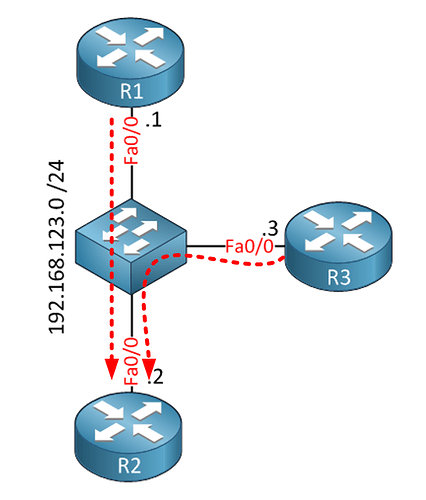This topic is to discuss the following lesson:
Dear Rene,
Could you explain where practically (Scenario) this would be used?
Regards,
Rajiv R
Hello,
I would like to ask if any non-resv-send-limit was configured on R3. I can see some Non Resv Send Limit values for current DSBM outputs. Also on R3 output there is no Non Resv Send Limit displayed for Local Configuration.
One small remark is for the Configuration tab / R3 at the end of the chapter. There should be an ip rsvp dsbm candidate.
Many thanks,
Stefanita
Hi Stefanita,
I didn’t configure anything on purpose, but there are some default RSVP commands. Here are all rsvp commands we configured:
R3#show run | include rsvp
ip rsvp bandwidth 2048And here are all default
R3#show run all | include rsvp
ip rsvp bandwidth 2048 2048
ip rsvp signalling fast-local-repair wait-time 0
ip rsvp burst policing 200
ip rsvp dsbm candidate 64
ip rsvp dsbm non-resv-send-limit rate 2147484
ip rsvp dsbm non-resv-send-limit burst 2147484
ip rsvp dsbm non-resv-send-limit peak 2147484
ip rsvp dsbm non-resv-send-limit min-unit 1
ip rsvp dsbm non-resv-send-limit max-unit 2147483647
ip rsvp policy cops timeout 300
ip rsvp pq-profile 12288 592 110
ip rsvp signalling initial-retransmit-delay 1000
ip rsvp signalling refresh reduction ack-delay 250
ip rsvp signalling refresh interval 30000
ip rsvp signalling refresh misses 4
ip rsvp authentication type md5
ip rsvp authentication lifetime 00:30:00Thanks, I just fixed this!
Rene
Hi,
I understood your example and config great, the only thing i didn’t quite get was the “oversubscribe” meaning and why this is the reason we need to use DSBM…
Thanks again
Hello Michael
Oversubscribing refers to the practice of designing a network, or arranging network traffic patterns, in such a way as to end up having more traffic arrive at an interface than it is able to carry. In other words, if you oversubscribe a particular network path, or interface, you are essentially creating a bottleneck.
For example, take a look at this diagram from the lesson:
Imagine we have traffic arriving from R3 and from R1, being routed towards R2. Note that all of the router interfaces are FastEthernet 100Mbps interfaces. Imagine that at a particular point in time, R3 is sending 60 Mbps to R2, and R1 is sending 80 Mbps to R2. Because R2’s interface can handle only up to 100Mbps, this interface is considered oversubscribed.
Network traffic patterns, as well as general network architecture must be designed in such a way as to minimize these types of oversubscriptions. Sometimes, however, they do occur, even in the best network design, because user traffic patterns cannot always be successfully forecasted.
This is where the DSBM feature becomes useful, as it creates a centralized location where all RSVP information is kept within a particular network segment. The DSBM can manage the bandwidth within the segment appropriately to avoid the oversubscription of any single interface.
I hope this has been helpful!
Laz
